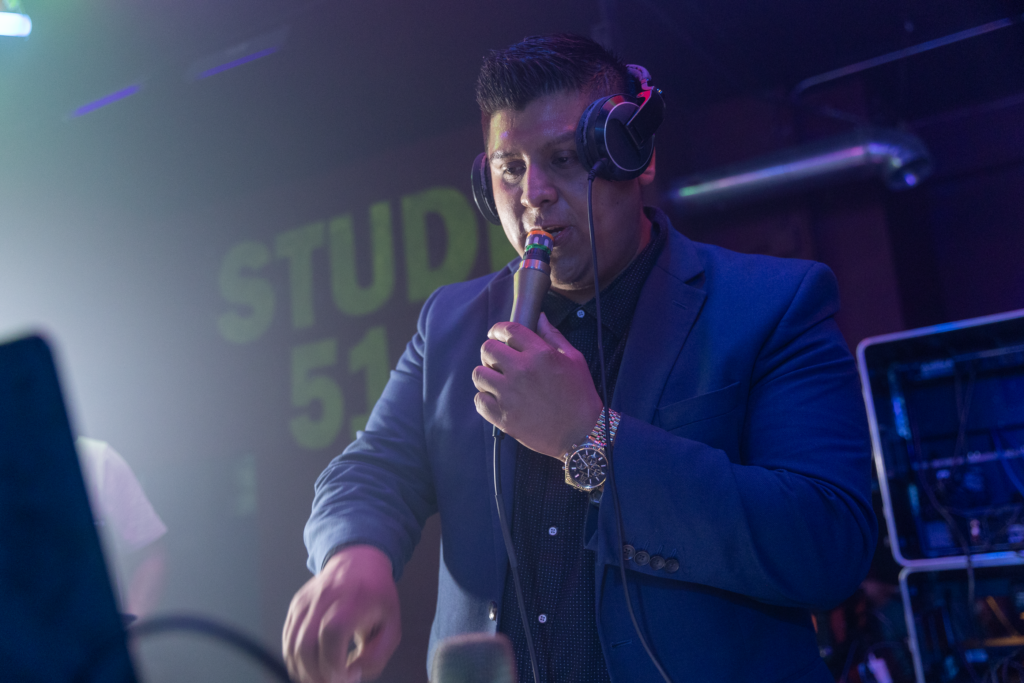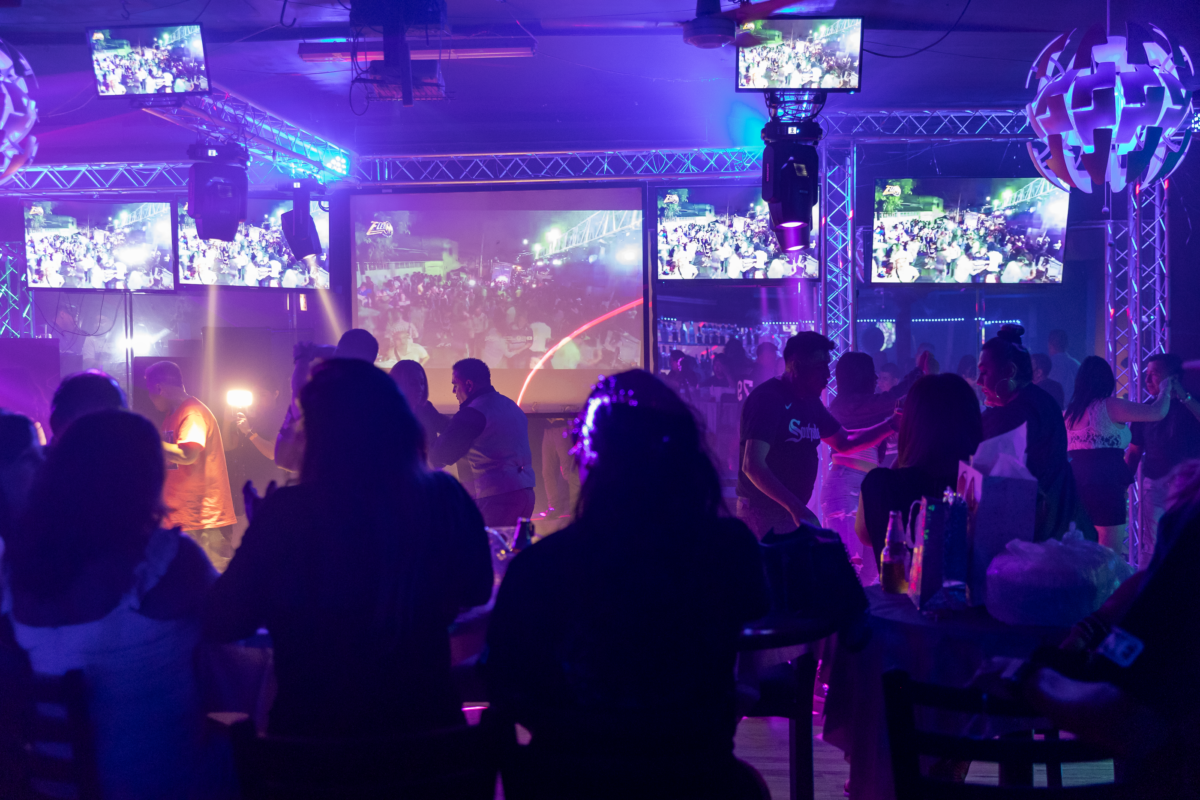A summer spent at Gage Park’s Studio 51 is a blur of shots, laser lights, and sequin dresses. Every Friday and Saturday night, women twirl across the dance floor, their partners catching them in perfect time with the music. Outside, people pass around cigarettes like whispered gossip, and a man sells bags of chicharrones to partiers exiting the club.
Known locally, as “la catedral de los sonidos” or “the cathedral of sounds,” Studio 51 has been the go-to spot to hear cumbia in Chicago since the nineties. But if you were there this past summer, you may have heard a little something new—a bit of hip-hop or techno, snuck in by a new vanguard of cumbia-heads who have been shaking up Chicago’s scene by mixing the genre’s familiar rhythms with more contemporary sounds.
“I think right now, we’re living in what some people would call a cumbia renaissance,” said Citlalic Jeffers Peña, a.k.a DJ La Colocha who recently played at Studio 51’s Gran Bailazo event this past August. Peña is one of a few Chicago DJs in recent years that have been mixing cumbia classics with more contemporary influences like new wave, electronica, and punk. Along the way, she and others in the Chicago scene are paying homage to cumbia’s rich history at spaces like Studio 51 and across the city as more venues welcome new takes on an old sound.
A cumbia connoisseur, Peña described her DJing as “a journey across timelines and across mediums.” She is heavily influenced by cumbia’s historical ties with sonidero culture, a sound system scene, or ambiente, that first arose in working-class communities in 1950s Mexico City like Iztapalapa, where her family is from. At the time, folks in these communities were either unwelcome in the city’s dance halls or lived in neighborhoods that were difficult to access. As a result, people began to close off their neighborhoods for big Bailes, block parties with music and dancing. This gave rise to sonideros, emcees that would build their own massive sound systems for spinning records.

Cumbia sonidera is “barrio sound,” said Maneul Chavira Sr., a Studio 51 veteran who has been on the mic as sonidero Arcania since the early 2000’s. The Weekly spoke with Chavira Sr. ahead of his 4To Festival Sonidero, a yearly sonidero festival held in the parking lot of Little Village’s Mi Tierra restaurant that attracted a crowd of a few hundred this past August. Now in its fourth year, the festival attracts sonideros from across the Midwest who are eager to showcase the culture’s wide sonic diversity.
Sonideros have different sounds depending on what neighborhood in Mexico City they are from, Chavira Sr said. The Chaviras represent el barrio de Mexico. Other sonideros like sonido Canandonga were also at the festival, representing neighborhoods like Tepito, which has more of a salsa sound popular in parts of Brazil, Puerto Rico, and Colombia. Others, like sonido Disco Movil Oso from Milwaukee, represent the Mexican state of Puebla with a sound that Chavira Sr. described as more recognizably Mexican. “We all repeat different styles, but with the same interest of entertaining people,” he said.
Cumbia had a long journey before it found the sonideros. A percussion-heavy genre that some describe as having a “chu-chucu-chu” rhythm, cumbia’s roots can be traced to the funeral traditions of Afro-Indigenous communities in colonial-era Colombia. In its early form, cumbia’s signature rhythms were played with the guacharaca, a tube-like instrument played with a small rake designed for scratching out a raspy beat. Eventually, cumbia traveled up through Central America to Mexico, where it became the music most people are familiar with today, adding more brass and piano. In more recent years, producers in New York and L.A., have picked up the genre, turning the old-school rhythms into a worldwide sound.
The popularity of cumbia sonidera has ebbed and flowed over the years as new waves of immigration from Mexico and Latin America brought the culture to the States, said Peña. When Manuel Chavira Sr. first arrived in Chicago in the early ’90s, legendary Mexican sonideros like La Changa would spin cumbia at major venues such as the Aragon Ballroom. “When you talk to older generations, they remember going to Aragon to see La Changa,” Peña said. “There has always been a scene for cumbia. I think sometimes people just don’t have access or don’t know where to go.”
Part of that scene has been places like Studio 51, which has been bumping cumbia since it first opened in 1993. Performing with Peña at Studio 51 in August was Chavira’s son, Manuel Chavira Jr., who in recent years has taken up the Arcania mantle. While on the mic, Chavira Jr. gives saludos, or shoutouts, to hype up the crowd. Less like traditional DJs, sonideros are more like emcees. These shoutouts can take the form of commentary on upcoming songs, or praise for someone putting in the work on the dance floor.
Peña has begun integrating saludos into her own mixes as DJ La Colocha. If you catch her at her California Clipper residency in Humboldt Park, or when she performs at Simone’s in Pilsen, you may just get a shoutout of your own. Other DJs, like Peña’s friend and frequent collaborator DJ Trumbull Shadow, are also doing shoutouts on the mic (Shadow’s saludos can be heard at his monthly cumbia night at Pilsen’s Penny Whistle Tavern). This past June, Shadow and Peña collaborated on an event with RUIDOSA!, a Latin American artist collective that often throws cumbia-centric pop-ups in the city. Peña helped curate the event’s lineup, bringing on DJ Alex Garcia, the son of local sonidero Bombo Latino. Together, the father-son duo host a popular Facebook livestream interviewing Midwest Sonideros.
“When I have an opportunity to recommend or curate or include, I’m always trying to include someone from the sonidero community or their kids,” Peña said. “Their kids are also coming up in the culture and it’s important to connect all of us so that we can keep the scene alive, growing and changing.”
As Chicago’s cumbia scene continues to change, it has also embraced a new subgenre, kumbia oscura, that mixes traditional cumbia with darker, punkier sounds—think synths, electronic pops and lots of heavy bass.
“Obviously it’s cumbia, but it’s not necessarily the mainstream cumbia that people are kind of used to hearing, or the things that they expect to kind of hear at their quince or a wedding,” Peña said. “I think it’s exploring the depths that the genre can go to beyond some of the things that we’re accustomed to hearing.”
One of the progenitors of this new sound is Flores Negras, a DJ and creator of the cumbia-adjacent rave series Mictlan Productions. Flores Negras performed at Thalia Hall’s Noche de Kumbia in September alongside fellow DJs Karenoid and Eva Maria. (Eva Maria also hosts a popular weekly cumbia night at Punch House in Pilsen.)
Flores Negras began her music career in Chicago’s punk and metal scene, performing as lead vocalist in the band Rosaries before switching to DJing during the pandemic. She said she brought her punk rock with her to the turntables, and likes to mix cumbia with metal, rock, merengue, and juke.
“It’s just real ratchet,” she said of her sound. “Cumbia goes hard!”
To get the darker sounds of kumbia oscura, Flores Negras will play two tracks simultaneously: one that skews techno, EDM, or industrial, and the other a cumbia classic she knows will mix well. “You can tell which songs have a happier note to it than the others, so I purposely look for those ones that sound darker or that have deeper voices,” she said. Her unique mix creates dancefloor moments that could seemingly only happen at a Flores Negras production. “Once I saw these people doing like a Cholo dance with my techno and that literally made my life, it was sick.”

According to Flores Negras, pre-pandemic, cumbia was really only being played in spaces for older adults, like sonidero events and spaces like Studio 51. It was rarer still to hear cumbia mixing with genres like punk and metal. “I played this one show a long time ago and it was a lot of rock and Español metal, and there was cumbia played in the middle of the sets,” Flores Negras said. “I was like, ‘This is so fucking sick,’ and they’re an older crowd so I was like, ‘This needs to be brought to the younger crowd.’”
In 2019, she started hosting a party called CUMBIA vs. new wave, combining cumbia with ’80s synths and electronica. When the pandemic came, this morphed into CUMBIA y Los goths, a virtual party where Flores Negras began to perfect her signature kumbia oscura style. You can see her live at her upcoming CUMBIA y Los Goths show on October 25 at Subterranean in Wicker Park.
Flores Negras has also been excited to see DJ’s like Peña and Trumbull Shadow incorporate old school cumbia sonidera culture with newer sounds, in particular at spaces like Studio 51 that have been celebrating the genre for decades. “
It’s been so sick to see. I remember when La Colocha just started doing that, I was like, ‘hell yeah’ because in Mexico those parties just have everyone dancing on the street and stuff and it’s cool to see it happening out here,” Flores Negras said. She hopes that DJs in Chicago will continue to push the envelope on cumbia’s possibilities and create more spaces for the genre to thrive.
“That music is home to us, and we deserve to feel like we’re at home.”
Charlie Kolodziej is a freelance journalist whose work has appeared in South Side Weekly, Windy City Times, and The Chicago Reader.

